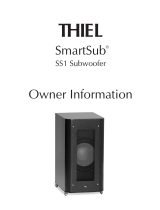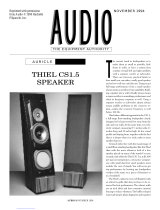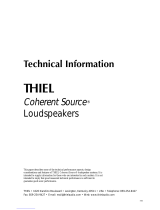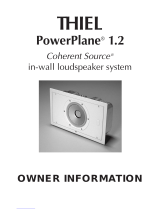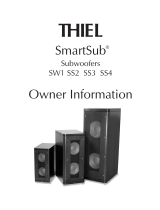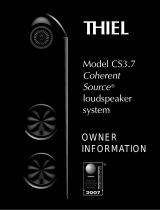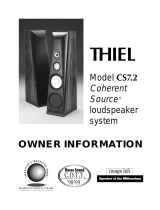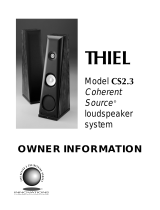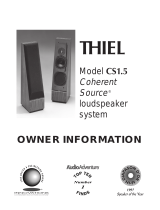Page is loading ...

2
THE THIEL AUDIO EXPERIENCE
Thank you for purchasing our 3rd Avenue Collection loudspeakers. Only the most
discerning listeners choose THIEL, and you’re going to love the vibrant sounds they
bring into your home.
THIEL stands for sound above all. Our mission is to conceive and build the world’s fin-
est loudspeakers—ones with the most perfect reproduction of sound possible. We’re
proud this series represents who we are as a company.
The THIEL in-house engineering team painstakingly designed and engineered these
ultimate performance loudspeakers to bring you the very best home entertainment
sound, just as the artists intended it to be experienced. THIEL speakers reproduce
sound in such a lifelike, realistic way that they create an emotional and sensory bond
between you and the artists.
Whatever its form, entertainment is the heartbeat of THIEL. We cannot live without
movies, music, live performances. That’s one of the main reasons we moved to Music
City—to be immersed in the very creativity and sound that for us and for you make life
worth living.
The 3rd Avenue Collection reveals our passion. In all we do, THIEL strives to meet
and exceed our customers’ audio desires and high expectations. That’s our commit-
ment to you.
What makes the 3rd Avenue Collection so special?
The 3rd Avenue Collection loudspeakers demonstrate THIEL’s flair for design and our
meticulous attention to the execution of each design. This series provides you with
a range of options to create either a fantastic two-channel or surround sound home
entertainment system. Developing this full range of speakers for surround sound is a
first for THIEL.
Our holistic design goal is for all THIEL products to have high dynamic capability,
which means they accurately deliver the lowest and highest frequencies—plus
everything in between—at high sound pressure levels. THIEL speakers accurately
reproduce not only barely audible sounds like whispers, but also very loud sounds like
explosions. Our component (driver) design and engineering are key to achieving that
wide-spectrum performance.
In terms of the acoustic components, THIEL’s engineering team:
• Designed a multi-order crossover that smoothly and expertly directs your
amplifier’s signals to the woofer, mid bass, midrange, and tweeter.
• Engineered proprietary mid bass, midranges, and woofers—designing optimal
components and using the best possible materials for each speaker in the series.
As a result, you hear cleanly reproduced, complex bass and midrange frequencies …
the ones that make you want to groove.
• Customized a titanium dome tweeter that deftly handles all of the high frequencies …
the ones that make movie soundtracks and music shimmer.
• Optimized back ports to limit interference with the recorded sound.
The speakers’ exterior emphasizes sleek, curved lines. In re-imagining the cabinets of
the 3rd Avenue Collection, the THIEL engineering team used large-radius curves on
either side of the baffle to reduce the bending of high-frequency sound waves around
the speaker baffles. In tech speak that means fewer diffractions. And we built in ex-
treme cabinet rigidity to eliminate audible resonances. The result for you is pure, clear,
lifelike sound filling your entertainment room.
The THIEL secret is in blending all of the design elements into a consummate execution.
Your new speakers will crisply reproduce the sounds as they were recorded—shifting
quickly and smoothly from the highest to the lowest frequencies, keeping all details
clear, and banishing audible distortion. All of which means you’ll be totally immersed in
the action and drama of movie soundtracks or performances, and riveted by the quiet
and complex musical passages of your favorite artists.

3
YOUR ENTERTAINMENT ROOM
Experiencing the most pleasure from your speakers depends on the room you’ve
chosen for watching movies and listening to music. Because every room is different,
THIEL offers general rules on speaker positioning in the paragraphs below for both
two-channel and surround sound systems. The variables covered include room size,
the position of your favorite sofa or chair, and room furnishings. We encourage you to
experiment with the placement of your THIEL speakers and with your furnishings to
achieve the sound results that best suit your taste.
The 3rd Avenue Collection speakers are high-performance sound reproducers and
work best when you pair them with the best sound system equipment. Because THIEL
speakers are extremely accurate, they will reveal sources of distortion generated else-
where within your system, for example from poor quality cables, an inferior or inade-
quate amplifier, or inferior electronics. Poor recordings, which sometimes happen, will
also be reproduced with stunning accuracy by your THIEL speakers!
We recommend that you use clean gloves when handling
the speakers so that no smudges occur on the cabinets.
The two-channel/stereo environment
A reasonably large room gives you the flexibility to position a pair of speakers (book-
shelf or tower) away from all of the walls. Your room’s walls do have various effects on
the speakers’ sound. In general, when a speaker is close to a wall, the bass response
is stronger. Consider the following:
• In a large room, if you’re using bookshelf speakers (the TM3s), you may want to
move them closer to the corners of the room for more bass, if that’s your preference.
• In a small room, however, the bass from the bookshelf speakers may suit your taste
just fine when the speakers are well away from the walls and corners.
• In a small room, if you’re using tower speakers (the TT1s), you can position them
well away from the walls and corners for less bass.
Typically, the bass is amplified in a small room. If your listening space is small, you may
feel as though the bass “room gain” (the effect of the room itself on the bass) is exces-
sive. In that case, use the port plugs (enclosed in the original box) to seal the back port
opening on each speaker. That should give you a more realistic sounding bass and a
better balance with the midrange and high frequencies.
In a two-channel/stereo set-up, the THIEL speakers’ mid and high frequencies sound
best when the speakers are not against or near any walls.
Reflected sound
Imagine you’re sitting in a favorite chair or sofa inside a sphere. Sound comes toward
you from all directions, vertically and horizontally. In any room no matter the size, you
want the primary sound from the speakers to be distinctly separated in time from the
secondary sound, which is reflected off of your walls and furniture.
Figure 1 shows that in a two-channel system, by positioning the speakers away from your
room’s walls, the arrival of the primary sound waves is well separated from the arrival of
Caution:
Do not bend the grilles. Bending the grilles will cause permanent
damage, and the grilles will no longer properly mount to the baffles.
The THIEL engineering team designed the grilles to protect the speakers’
components. If you have not already done so, please attach each magnetic
grille (included in the original box) to the front of the speakers right now—
aligning each grille with the top of the speaker.
If you must remove the grille at some later time, use both hands to carefully pull
the grille frame away from the front of the speaker. Do not twist or bend the grille.
Figure 1

4
the secondary, reflected sound waves. That provides the proper delay needed by our
ears to appreciate the spatial separation of instruments and vocals.
In a two-channel/stereo environment, we recommend you sit at least 6.5 feet (about 2
meters) from the speakers. As a general rule, your two speakers and favorite sofa or
chair should form the three points of an equilateral triangle, which means the speakers
are as far from you as they are from each other. That is a good starting point. Depend-
ing on the size of your room, the sensitivity of your ears, and the reflectivity of the walls,
you can point the speakers straight ahead and directly at you, or angle them in directly
at you.
If, because of your room’s size or layout, your speakers must be close to the side
walls, use an angled in (or a toed-in) position for both speakers to weaken the side-wall
reflections and focus the sound on where you’re seated. Other adjustments you can
experiment with to make the sound suit your preference include:
• Widening the space between the speakers. If your speakers are too close to each other,
the lifelike sound that the THIEL Left/Right speakers are designed to produce will be
less distinct than it should be.
• Angling-in the speakers as you increase the width between them.
• Increasing the space between the speakers and the back wall.
• Increasing the distance of your favorite chair or sofa from the speakers.
• Adjusting your room’s décor.
Furnishings
Yes, furnishings affect your audio experience in both stereo and surround sound
environments. First, avoid placing any large objects (furniture or artwork) close to the
speakers because sound waves will reflect off those objects and alter your enjoyment.
Then, evaluate your room’s acoustic personality. From an audio perspective, rooms are
described as “live” or “dead.”
You have a “live” room if its décor includes a lot of glass, hardwoods (floor, furniture),
and other hard surfaces that reflect sound coming from the speakers. Those types of
furnishings alone may make the recorded tones sharper than you expect or like.
• A wood or glass table between you and the speakers reflects sound away from you.
Move that table to the side of your chair or sofa, if possible.
• To soften the effects of a hardwood floor, add an area rug or carpet between you
and the speakers.
• Hanging soft materials (small rugs or tapestries) on side walls or positioning a
bookcase (without doors) on a side wall can also reduce sound reflection.
You have a “dead” room acoustically speaking if it is decorated with heavy carpet,
drapes, and upholstered furniture. They absorb sound and can make the recorded
details softer or less distinct than you expect or like.
• While removing the carpet in your room may be impractical, you can try removing some of
the upholstered furniture, adding glass or wood pieces, or using a different (less soft) window
covering to help make the sounds more distinct.
Depending on your furnishings, you may need to continue experimenting further with
the placement and angling of your speakers and the location of your favorite sofa or
chair. By trying some of the suggestions above, you’re sure to create the right environ-
ment to enjoy your favorite entertainment.
THE SURROUND SOUND SET UP
Surround sound home entertainment makes you feel right inside the movie’s action or
in the best seats at a concert. If you’re are not sure how many speakers you want for
your home entertainment room, it’s easy to start with a 5.1 system from THIEL, using
one center speaker (a TC1), a subwoofer, a pair of tower speakers (TT1), and a pair
of TM3 bookshelf speakers (on stands or wall-mounted). We’ve designed this series
of speakers to complement each other.
Later, you can easily add a pair of surround sound speakers to that fine array to create
a 7.1 system.
Figure 2 shows the recommended speaker positions in relation to you and each other
for two surround sound options, 5.1 and 7.1. The left/right speakers in a 5.1 system
should either be in line with your sofa/chair, or just behind it. We recommend placing
those speakers on stands or mounting them on the wall so their tweeters are at ear
level when you’re seated. The surround sound speakers should be at ear level or
higher when you’re seated.

5
The Center Channel
Note that the center speaker, the TC1, is typically positioned below ear level but
angled so that the tweeter (the central 1” driver above the 3.5” midrange driver) is
directed toward ear level, as in Figure 3.1.
If you place the center speaker above ear level (for example, mounted on top of a cabi-
net as in Figure 3.2, above), then the center speaker should be rotated 180 degrees for
correct performance. In order to rotate the center speaker 180 degrees, simply place
the speaker on the side that was previously on top (tweeter above the midrange driver),
so that the tweeter is now below the midrange driver (as in Figure 3.2), allowing the
sound to better disperse at this new height.
Speaker binding posts
Cables come with pin connectors, banana plugs, spade connectors, looped wire, or
straight wire. The THIEL 3rd Avenue Collection is equipped with 5-way binding posts
to accept any of these connectors. Our speakers’ binding posts allow for a very solid
connection with the cables you select.
Figure 4.1 and Figure 4.2 show the THIEL TM3 terminal plate and TC1 terminal plate,
which have two binding posts each.
The TT1 in the 3rd Avenue Collection has four post bindings or two pairs of terminals
at the back (see Figure 4.3). Leave the jumper strap in place and use a cable to attach
each speaker to a separate channel of your amplifier.
Figure 3.1 Figure 3.2
Typical 5.1 Speaker Placement Typical 7.1 Speaker Placement
Figure 2
Figure 4.1
Figure 4.2
TM3
TC1
Figure 4.3
TT1

6
Connecting your speakers to the amplifier/receiver
While speaker set-up can be daunting, wire set-up is relatively easy. Before connecting
your speaker cables to the terminals and appropriate components, prepare and inter-
connect the amplifier, preamp, and additional music systems as per each component’s
instructions.
For correct and lifelike sound reproduction, both speakers in a stereo system must
be wired in the same polarity. The speaker’s input terminals are color coded to make
connecting the cables straight-forward.
• The wire connected to the red-ringed input terminal of each speaker should connect to the
respective positive (+) output terminals of the amplifier/receiver.
• The wire connected to the black-ringed input terminals should be connected to the
respective negative (–) output terminals of the amplifier/receiver.
It is important to note that the quality of the speaker cables and other interconnections
significantly affects the performance of your entertainment system.
Speaker cables
The shipping boxes do not contain the cables (wiring) needed to connect the speakers
to your amplifier/receiver. Cables must be purchased separately. It’s important to know
that old or inexpensive speaker cables can diminish the sound quality of your THIEL
speakers. It pays to use high-quality, low-gauge cables to connect your speakers to the
amplifier/receiver. Low-gauge cables ensure minimal loss of power (thanks to reduced
impedance) and proper control by the amplifier. Consider these factors when choosing
cables for your sound system: gauge and length.
Gauge. All speaker cables have an American Wire Gauge (AWG) number (ranging
from 0000 to 40) that indicates the thickness of the wire’s copper bundle (the all-
important electric conductor). A lower gauge means a thicker wire. And the thicker the
wire, the better it conducts the signal from your amplifier to your speakers. Speaker
cables used with stereo and home entertainment systems typically range from 10
gauge to 18 gauge.
Length. Cable length also affects sound quality. For example, bookshelf speakers are
often placed relatively close to the receiver or amplifier (within 6.5 feet); in that case,
you can use shorter, higher gauge (18 AWG), less expensive cables. However, if you
need or want to run cables longer than that, refer to Figure 5 as a guide to the best
gauge for your home system.
We recommend using cables of nearly the same length (plus or minus 1 foot) for each
speaker. By using similar lengths of cable to connect your speakers to the amplifier/re-
ceiver, you’ll ensure that the speakers receive similar power and produce a similar sound
at a given volume.
Bi-amping
If you’re using a high-quality amplifier with high output capacity for your two-channel/
stereo system, there is probably no need to bi-amp. However, the limitations of your
current amplifier may persuade you to bi-amp your stereo system. If, for example, your
amplifier has a small output capability (in terms of watts) or you routinely play your
amplifier at high volume (it’s “overdriven”), distortion will occur. That happens because
with one, average-quality amplifier, most of the power goes to the woofer (handling
the low frequencies); so playing the stereo system at high volume distorts the higher
frequencies.
Bi-amping uses one amplifier for the low frequencies and a second amplifier for the mid
and high frequencies. Having two amplifiers means less distortion is audible in the mid
and high frequencies when your system is played at high volume or your amplifier is not
of high quality.
Figure 5
GAUGE
(AWG)
LENGTH IN METERS (M)
FROM THE SPEAKER TO
THE AMPLIFIER/RECEIVER
LENGTH IN FEET/INCHES
FROM THE SPEAKER TO
THE AMPLIFIER/RECEIVER
18 2M 6’ 6”
17 2.3M 7’ 5”
16 3M 9’ 8”
15 3.4M 11’
14 4M 13’
13 5M 16’ 4”
12 7M 23’
11 7.7M > 25’

7
Given the limits of your amplifier, if you do
decide to bi-amp the TT1 loudspeakers,
first detach the jumper straps (see Figure
6). Then use two cables to attach each
pair of binding posts on the speaker to a
separate amplifier.
THIEL speakers benefit from a higher cur-
rent, higher quality amplifier (for example,
8 ohm). If you’re connecting the speakers
to an amplifier with various impedance
taps, the nominal impedance of the 3rd
Avenue Collection is 8 ohm; the minimal
impedance is 3 to 4 ohm.
Power requirements of your amplifier
It is important to have enough music power from the amplifier to play the artists you
love at the volume level you desire without distortion.
• If you play the speakers more loudly than the volume your amplifier can cleanly produce,
the amplifier will create what is called overload (clipping) distortion. The sound will
become compressed, strained, and in extreme cases, obviously distorted.
• This distortion is actually nonmusical additional energy. It is concentrated in the high
frequency region, and the tweeter can be damaged in extreme cases.
Sound quality is usually more important to discerning listeners than sound quantity.
Two amplifiers of equal power can have large differences in their sonic performance.
And that is more important than large differences in power.
Most discriminating listeners will be happier with a 100-watt amplifier of high sonic
quality than a 200-watt amplifier of mediocre quality. For that reason, we feel there is
no substitute for listening carefully when selecting your amplifier.
The question “How much power do I need?” does not have the simple answer most
people expect. The music power needed is determined by three factors: the volume
you prefer, the size of your room, and the speaker’s efficiency rating. Each factor can
raise or lower the average (100 watts) by two or more times.
As shown in Figure 7, a small or average (medium) size room will need less power for a
given loudness level than a large room. Specifically, a very small room (1,000 cu ft or
about 11’ x 11’ with an 8’ ceiling) will require about half the power of a medium size
room. A large room (6,000 cu ft or 20’ x 30’ with a 10’ ceiling) will require twice the
power of a medium size room.
• If your listening room is connected to another room by a large open area, the
required power will increase, but not by the amount of the combined room volume.
• If your listening room has a “dropped” ceiling with light panels, the ceiling will be
almost transparent acoustically and the space above the ceiling should be counted in
the room size. If the light panels are heavy, they will act as a more normal ceiling.
A speaker with a low efficiency rating will require twice the power of a speaker with
average efficiency. And a speaker with a high efficiency rating will require only half the
power of a speaker with average efficiency.
On average, you should have an amplifier that is 100 watts per channel. The minimum
power, average power, and maximum power all depend on the particular speaker model
(see Figure 8).
Figure 6
ROOM SIZE
A V E R A G E
VOLUME TURN IT UP!
SMALL (1K CU FT) 50 W 100W
MEDIUM (2K-5K CU FT) 100W 200W
LARGE (6K+ CU FT) 200W 400+W
Figure 7 Eff iciency Rating
ROOM SIZE DB/2.8 V-1M AVERAGE
WATTS/SPEAKER
SMALL (1K CU FT) LOW
84 200W
MEDIUM (2K-5K CU FT) A V E R A G E
87 100W
LARGE (6K+ CU FT) HIGH
90 50W
Figure 8 Listening Preference
TT1

8
ACCESSORIES
THIEL Tower 1
Stabilizer spikes and threaded rubber bumpers: In the gift box are eight stabilizer
spike sets (pin, washer and puck) and eight threaded black rubber bumpers.
Speakers positioned on a soft or uneven surface are able to rock slightly and will
vibrate in reaction to the forces that the speaker generates to move the driver di-
aphragms. (Every action has an equal and opposite reaction). This motion slightly
reduces the music’s clarity. To eliminate this effect, the TT1s can be used with four
stabilizer spikes or threaded rubber bumpers to provide a more solid footing and allow
the speakers to couple more firmly to the floor.
The floor type in your listening environment will determine which variety is best for
your particular application. The stabilizer spike is recommended if the speakers will
be placed on a rug or carpet, as the spike’s tip will pierce the soft material to ensure
greater stability. If the speakers will be directly on the floor, it is advisable to use the
stabilizer spike with the spike puck or the threaded rubber bumper to prevent scratch-
es or marks to the floor.The speakers should be positioned before the stabilizer feet or
threaded rubber bumpers are installed.
Caution:
Be cautioned that it is possible to mar the floor’s surface if the speakers
are moved with the spikes in place. Please utilize the spike puck to protect
the floor from any potential damage that such movement could cause.
To install:
{Installation is the same for the threaded black rubber bumper except no washer
or base is required.}
1. Position the speaker in the desired location.
2. Tilt the speaker forward slightly so that the back of the speaker is a few
inches off of the floor.
3. Screw one spike, with the locking nut threaded all the way onto the spike,
into each of the two holes at the back corners of the speaker bottom. The
pins should be screwed into the speaker until there is about ¼ inch of
thread remaining visible.
4. Let the back of the speaker down, and then tilt the speaker backward
slightly so that the front is a few inches off the floor and install the two front
spikes.
5. With all four spikes installed, the height of each spike should be adjusted so
that the speaker stands firmly on the floor without wobbling. Then, tighten
the lock nuts by turning them so they are tight against the cabinet to secure
the spikes to the cabinet.
THIEL Monitor 3
Adhesive Pads: Included in the gift box is a set of clear adhesive-backed rubber pads
to provide optional protection and cushioning between the bottom of the speaker and
the surface upon which it rests.
To apply, carefully tilt the TM3 back and adhere a rubber pad to each corner of the
base of the speaker; stand upright when finished.
CABINET CARE
The THIEL speaker cabinets are carefully crafted using quality materials and veneers.
We recommend using a damp microfiber (soft) cloth to dust or clean them. Avoid
rough cloths because they will scratch the high-gloss painted finish of the speaker
cabinets.
SERVICE
We’ve scoured the globe for the highest quality materials and the most talented, reli-
able manufacturers who use only our designs to produce fault-free components (parts)
to THIEL’s exacting specifications. Our suppliers work in the United States, Europe,
and Indonesia. Each THIEL speaker is assembled and tested multiple times in our
Nashville, Tennessee facility. We stake our reputation on our design specifications
and quality control.

9
If your speaker system requires service, contact your authorized THIEL Audio dealer.
If you need to contact THIEL directly, service information and technical support is
available at (615) 913-8532, Monday-Friday, 8:30 a.m. to 5:00 p.m. Eastern Time, or
via e-mail at [email protected].
THIEL dealer information and Frequently Asked Questions are available on our website
(www.thielaudio.com).
LIMITED WARRANTY
THIEL warrants every THIEL speaker and subwoofer against defects in materials and
workmanship to the original owner for a period of ten years for the drivers and cabinet,
and five years for the electronics from the date of purchase. THIEL will, at no charge,
replace any defective part and make any repairs necessary to ensure its proper perfor-
mance when the defective unit is returned to us postpaid. This warranty does not cover
damage due to accident or abuse and is void if the unit has been tampered with.
This warranty is automatic and no registration is required. This warranty gives you,
the owner, specific legal rights. You may also have other rights which are particular
to your state.
CONTACT
(615) 913.8532
facebook.com/thiel.loudspeakers
twitter.com/THIELAudio
linkedin.com/company/thiel-audio
Follow us online:
www.THIELaudio.com
THIEL Audio
750 Old Hickory Boulevard
Building 2, Suite 275
Nashville, Tennessee 37027
The following information is for your records:
Serial Numbers______________________________
Purchase Date_______________________________
Purchased From_____________________________
You can also register your warranty online at
www.THIELaudio.com/registrations/new

10
PRODUCT SPECIFICATIONS
UOM BANDWIDTH
ANECHOIC
SENSITIVITY
(2.83V AT 1M)
IN-ROOM
SENSITIVITY
RECOMMENDED
POWER (W)
DRIVER
COMPLIMENT
CROSSOVER
DESCRIPTION
NOMINAL
IMPEDANCE
MINIMUM
IMPEDANCE
GRILL BINDING
POSTS
DIMENSIONS
INCHES / MM MISCELLANEOUS ACCESSORIES
MODEL
TT1 pair 39Hz to 30KHz 88dB 91dB 20-250
• 1” Titanium dome
tweeter
• 4.25” Midrange with
fiberglass cone
• 2 x6.5” Woofer with
aluminum cone
3-way Multi-Order Ampli-
tude and Phase Response
Optimized Design, Air Core
Inductors, Film Capacitors,
FR4 PCB
83.7
Perforated metal
secured with NEO
magnets with fine
knit acoustically
transparent cloth
5-way all
metal, 2 pair
41.06” (h) x 10.24” (w) x 10.00” (d)
1043 (h) x 260 (w) x 328 (d)
Metal Spikes
and Threaded
Rubber Bumpers
TM3 pair 48Hz to 30KHz 87dB 90dB 20-150
• 1” Titanium dome
tweeter
• 6.5” Woofer with
fiberglass cones
2-way Multi-Order Ampli-
tude and Phase Response
Optimized Design, Air Core
Inductors, Film Capacitors,
FR4 PCB
83.6
Perforated metal
secured with NEO
magnets with fine
knit acoustically
transparent cloth
5-way all
metal, 1 pair
17.09” (h) x 9.84” (w) x10.91” (d)
434 (h) x 250 (w) x 277 (d)
Silicone Rubber
Bumpers
Optional Stands
and Wall Bracket
Adapter
TC1 each 54Hz to 30KHz 87dB 90dB 20-200
• 1” Titanium dome
tweeter
• 3.5” Midrange with
fiberglass cone
• 2 x 6.5” Woofers with
aluminum cones
3-way Multi-Order Ampli-
tude and Phase Response
Optimized Design, Air Core
Inductors, Film Capacitors,
FR4 PCB
84.7
Perforated metal
secured with NEO
magnets with fine
knit acoustically
transparent cloth
5-way all
metal, 1 pair
9.84” (h) x 25.0” (w) x 10.82” (d)
250 (h) x 635 (w) x 275 (d)
Silicone Rubber
Bumpers
Aluminum Base
Included
Optional Stand

11
PRODUCT SPECIFICATIONS
UOM BANDWIDTH
ANECHOIC
SENSITIVITY
(2.83V AT 1M)
IN-ROOM
SENSITIVITY
RECOMMENDED
POWER (W)
DRIVER
COMPLIMENT
CROSSOVER
DESCRIPTION
NOMINAL
IMPEDANCE
MINIMUM
IMPEDANCE
GRILL BINDING
POSTS
DIMENSIONS
INCHES / MM MISCELLANEOUS ACCESSORIES
MODEL
TT1 pair 39Hz to 30KHz 88dB 91dB 20-250
• 1” Titanium dome
tweeter
• 4.25” Midrange with
fiberglass cone
• 2 x6.5” Woofer with
aluminum cone
3-way Multi-Order Ampli-
tude and Phase Response
Optimized Design, Air Core
Inductors, Film Capacitors,
FR4 PCB
83.7
Perforated metal
secured with NEO
magnets with fine
knit acoustically
transparent cloth
5-way all
metal, 2 pair
41.06” (h) x 10.24” (w) x 10.00” (d)
1043 (h) x 260 (w) x 328 (d)
Metal Spikes
and Threaded
Rubber Bumpers
TM3 pair 48Hz to 30KHz 87dB 90dB 20-150
• 1” Titanium dome
tweeter
• 6.5” Woofer with
fiberglass cones
2-way Multi-Order Ampli-
tude and Phase Response
Optimized Design, Air Core
Inductors, Film Capacitors,
FR4 PCB
83.6
Perforated metal
secured with NEO
magnets with fine
knit acoustically
transparent cloth
5-way all
metal, 1 pair
17.09” (h) x 9.84” (w) x10.91” (d)
434 (h) x 250 (w) x 277 (d)
Silicone Rubber
Bumpers
Optional Stands
and Wall Bracket
Adapter
TC1 each 54Hz to 30KHz 87dB 90dB 20-200
• 1” Titanium dome
tweeter
• 3.5” Midrange with
fiberglass cone
• 2 x 6.5” Woofers with
aluminum cones
3-way Multi-Order Ampli-
tude and Phase Response
Optimized Design, Air Core
Inductors, Film Capacitors,
FR4 PCB
84.7
Perforated metal
secured with NEO
magnets with fine
knit acoustically
transparent cloth
5-way all
metal, 1 pair
9.84” (h) x 25.0” (w) x 10.82” (d)
250 (h) x 635 (w) x 275 (d)
Silicone Rubber
Bumpers
Aluminum Base
Included
Optional Stand
CROSSOVER FREQUENCIES
/


